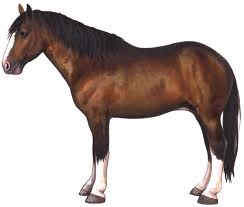Horse
| This article or section is being fought over by people undoing each other's changes. Please use the Discussion page for fighting instead of the article. |
 This page is needs images. Help plz. This page is needs images. Help plz. |

Horses (Equus ferus caballus) are a subspecies of odd toes ungulates native to the continent of Eurasia on planet Earth. Horses are quadrupedal herd dwelling herbivorous (specifically grazing) creatures that usually weigh between 250 and 1000 kilograms and are well adapted to long distance running. Starting around 4,000 BCE, horses were domesticated by humans, first for food, but eventually their primary use was as beasts of burden and in particular as mounts to carry humans about.
History
Like dogs, horse have been bred by humans into a wide variety of breeds for specialized purposes in different areas. Some are meant for racing, others are meant to carry large loads, and others are intended to carry people (including soldiers). An extensive list of horse breeds can be found here https://en.wikipedia.org/wiki/List_of_horse_breeds
More than any other non human animal (except maybe dogs) the horse has been a direct aide to humans at war as a beast of burden, draft animal and as a mount.While they can travel quickly over short distances, most horses which move faster than an infantryman tire if they are forced to march for too long, which can be lethal for them.
At first, they were mainly used to pull chariots- small lightly built carriage which could carry one or more guys into battle. Usually this would be a driver who had the reigns and either an archer or a guy with a spear. They were fast, but expensive to produce. However, until the stirrup was brought over to Europe difficulties with riding a horse on its own made chariots the only reliable way to use horses in battle.
When the stirrup did reach Europe, the chariot fell out of use in favor of mounted warriors such as knights. A combination of heavy armor, mobility, and devastating charges made knights on horseback dangerous foes, and even after the advent of firearms mounted soldiers were valued for their ability to outflank foes. As a result, cavalry of all types remained a major part of military units worldwide until the end of World War I.
In Traditional Games
Role-playing games set in the typical vaguely-medieval-European setting will invariably have horses (or some other setting-appropriate mount, like giant lizards or camels) available to speed travel and increase load capacity between locations. Certain classes, like knights, may have skills to use their horse in combat for increased speed and attack power. Caring for a horse is extremely complicated, to the point that real-world knights and horse-owning nobles had servants specifically tasked with managing the horse; they need to be fed, groomed, and fitted with equipment like horseshoes, saddles, and reins to operate at peak efficiency, and they are not as adaptable to terrain or as capable of sustaining a heavy pace as a human. Most role-players are more interested in crawling through dungeons than playing "Horse Stable Manager 1500", so the needs and capabilities of horses are usually kept well abstracted.
Greek mythology also includes legends of centaurs, creatures which consist of a man's upper body connected to a horse body at the shoulder (the horse-body's shoulder); naturally, role-playing games include them as monsters or player-character races.
The ancient Greeks believed that in far off lands there was a head horned creature called a unicorn, which coincided with a critter that was described in the old testament. Given the context of what they were talking about these were probably Indian Rhinos, but this did not stop European artists to imagine these creatures as being like Horses with horns based off Narwhal Tusks. Since the classical depiction of unicorn was a huge horse with a long sharp horn coming out of it's forehead which it could use to impale people with, in the middle ages the unicorn was a symbol of masculinity. Times have changed. Or did they...?